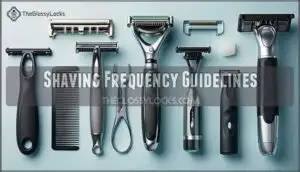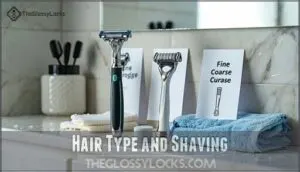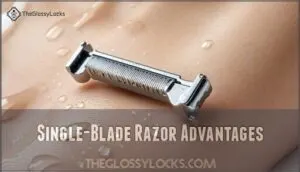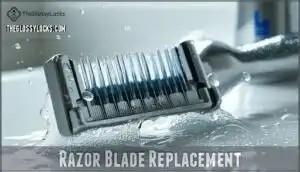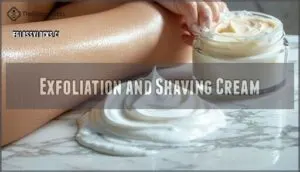This site is supported by our readers. We may earn a commission, at no cost to you, if you purchase through links.

Fine hair grows slower, so shaving every few days works. On the flip side, sensitive skin needs more breathing room—shaving every 3-4 days can help prevent irritation.
For underarms, aim for every 1-2 days, while legs and bikini areas can go 2-3 days or even a week, depending on your preferences. Just heed your skin’s cues—it’ll tell you when to grab the razor again.
Curious about razor care? Stay tuned.
Table Of Contents
- Key Takeaways
- Shaving Frequency Guidelines
- Hair Type and Shaving
- Razor Selection and Care
- Skin Health and Shaving
- Optimal Shaving Practices
- Frequently Asked Questions (FAQs)
- Is it normal to shave every 2 weeks?
- Is it good to take a break from shaving?
- How does climate affect shaving frequency?
- Does diet influence hair growth and shaving needs?
- Can shaving frequency impact facial hair texture?
- What are the effects of hormonal changes on shaving?
- How to manage shaving during travel or busy schedules?
- Conclusion
Key Takeaways
- Adjust your shaving frequency based on your hair type—coarse hair may need shaving every 1-2 days, while fine hair can go 2-3 days or longer.
- For sensitive skin, give it 2-3 days between shaves to prevent irritation and razor burn. Use hypoallergenic products for extra care.
- Shave with the grain, use a sharp blade, and prep your skin with warm water and a good shaving cream to avoid nicks and ingrown hairs.
- Use proper razor maintenance—replace blades every 5-10 shaves and store them dry to prevent rust and bacteria buildup.
Shaving Frequency Guidelines
Finding the right shaving schedule doesn’t have to be a guessing game.
Whether you’re after a baby-smooth finish or rocking some stubble, matching your routine to your hair type keeps your look sharp and your skin happy.
Smoothness and Hair Growth Rate
For ideal smoothness, shaving frequency hinges on your hair growth rate.
Hair regrowth varies, so adjust intervals based on your growth impact.
Here’s a quick guide:
- For fast growth, shave daily to maintain smoothness.
- Moderate growth? Every other day works.
- Slow growth? Aim for 2-3 days.
- Razor sharpness matters—replace blades regularly!
Clean-Shaven Appearance
Aiming for a clean-shaven look? Shave every 1-3 days, depending on your hair growth rate.
Pair proper shaving techniques with effective product selection for smooth, nick-free skin.
Keep skin sensitivity in mind and prioritize razor maintenance for best results.
| Schedule | Hair Type | Shaving Frequency |
|---|---|---|
| Thick/Coarse Hair | Resilient Skin | Every 1-2 days |
| Fine Hair | Sensitive Skin | Every 2-3 days |
| Uneven Growth | Combination Skin | Every 1-3 days |
Stubble Maintenance
Keeping stubble sharp is all about balance.
Shave every 2-3 days to manage growth, or use trimming tools daily for patchy stubble or specific styling needs.
Hair type and growth rate matter—faster growth means more upkeep.
Hydrate for stubble softness and avoid over-shaving to prevent irritation.
A little beard maintenance goes a long way in keeping it looking intentional.
Beard Trimming Schedules
Keeping your beard in shape means planning around your goals and hair type.
Here’s a quick cheat sheet:
- Trim every 1-2 days for sharp stubble upkeep.
- Target 2-3 weeks for short beard maintenance.
- For 4+ inches, trim every 6-8 weeks.
- Patchy beards? Add extra grooming, or consult a barber for pro tips.
Shape, tool choice, and coarseness matter! Daily application of beard oil conditions facial hair, keeping it soft.
Hair Type and Shaving
Your hair type plays a big role in how often you should shave, since coarse and fine hair grow at different rates and need different care.
Understanding what works best for your skin and hair can make shaving smoother—and save you from unnecessary nicks or irritation, which is crucial for maintaining healthy skin and hair.
Coarse Hair Shaving Needs
When dealing with coarse hair, prep is everything—soften it with warm water and pre-shave oil.
Shave every 1-3 days using a single-blade razor to minimize irritation, and always go with the grain to prevent ingrown hairs.
Avoid heavy pressure, as this can cause additional irritation, and ensure regular blade maintenance keeps your shave smooth.
Moisturizing post-shave locks in hydration, and these shaving tips make all the difference!
Fine Hair Shaving Requirements
Fine hair calls for a delicate shaving routine.
Use gentle razor options and moisturizing products to prevent irritation and ingrown hairs.
Shave with the grain for smoother results, reducing nicks.
Depending on hair density, adjust your shaving frequency—high-density fine hair may need more attention.
Minimal irritation techniques keep your skin happy, making shaving tips your best sidekick, with a focus on gentle razor options and moisturizing products.
Sensitive Skin Considerations
Sensitive skin needs extra care to stay happy.
Shaving every 2-3 days gives your skin time to recover, reducing irritation and razor burn.
Stick to sharp blades and choose a soothing shaving cream to avoid discomfort.
Exfoliation benefits you by preventing ingrown hairs, while an aftershave balm calms irritated spots.
Shaving with the grain can also minimize irritation.
Simple shaving solutions like shaving with the grain work wonders!
Oily and Dry Skin Shaving
Got oily or dry skin? Your shaving routine matters.
For oily skin, shave every other day to prevent clogged pores—don’t skip exfoliating.
Dry skin? Weekly shaving works best, paired with a balm to lock in moisture.
Always hydrate before and after shaving; your skin will thank you. The right products make any skin type happier and irritation-free!
Razor Selection and Care
Choosing the right razor and taking proper care of it can make a big difference in your shaving experience.
A sharp, well-maintained blade saves time, prevents irritation, and keeps your skin smooth without the hassle.
Multi-Blade Razor Benefits
Multi-blade razors offer closeness and blades designed to cut hair below the skin’s surface, giving that ultra-smooth feel.
Their efficiency reduces shaving frequency, as fewer passes are needed per session.
The technique importance lies in preparation—let the razor glide without applying pressure.
While cost considerations arise, these razors minimize irritation for most and reduce environmental impact due to durability.
Many consumers purchase replacement razor cartridges to extend the life of their razor.
Single-Blade Razor Advantages
Single-blade razors deliver a smooth shave while keeping things simple.
They’re ideal for eco-friendly shaving and work well for all hair types.
Plus, they’re cost-effective and last longer.
Here’s why they’re great:
- Fewer passes mean less irritation.
- Balanced blade sharpness guarantees a close shave.
- Technique simplicity suits beginners.
- Durable design reduces waste long-term.
Many prefer to buy quality shaving products for the best experience.
Electric Trimmer Usage
Using electric trimmers simplifies beard styling and adjusts easily to different hair types.
With trimmer attachments for precise control, you can shape stubble or trim thick beards.
Corded vs. cordless models offer flexibility—corded guarantees power while cordless shines for travel.
Trimming techniques matter too: slow, steady strokes suit hair coarseness.
For ideal results, consider trimmers with adjustable length settings for versatile beard styles.
Travel trimmers are compact, perfect for on-the-go grooming.
Razor Blade Replacement
Replacing razor blades on time keeps your shaves smooth and hassle-free. Watch for signs like tugging or dullness—they’re sharpness indicators it’s time for a switch.
Store blades dry to prevent rust and bacteria buildup.
- Replace blades every 5-10 shaves for razor longevity.
- Clean razors thoroughly after each use, using warm water.
- Keep extras handy; poor preparation costs time and comfort.
Skin Health and Shaving
Your skin’s health plays a big role in how often you should shave, especially if irritation or sensitivity is an issue.
By using proper techniques, the right products, and a little care, you can keep your skin happy and smooth without overdoing it.
Shaving Frequency and Skin Irritation
Shaving frequency plays a big role in avoiding skin irritation, razor burn, and ingrown hairs.
Sensitive skin benefits from shaving less often, allowing time to heal. Exfoliation benefits can’t be overstated—it helps prevent those pesky bumps.
Shave with care, hydrate beforehand, and follow the grain to reduce irritation. A little planning makes shaving smoother—literally, with exfoliation benefits being key, and shaving with care to avoid issues, ultimately leading to a smoother experience through proper planning.
Sensitive Skin Recovery Time
Sensitive skin needs time to heal, so lowering shaving frequency helps maintain its barrier function.
To reduce irritation and razor burn, follow these tips:
- Give your skin 48 hours to recover after shaving.
- Use gentle healing methods like aloe vera gel or fragrance-free moisturizers.
- Avoid product sensitivity by using hypoallergenic post-shave care.
- Watch for lingering skin irritation and adjust accordingly.
Consider using alcohol-free shaving creams to further minimize irritation and support the skin’s natural barrier function.
Exfoliation and Shaving Cream
Exfoliation works wonders by removing dead skin, letting your razor glide smoothly—think of it as clearing the path.
Look for shaving creams with hydrating ingredients like aloe or glycerin to protect against irritation. Apply it generously in circular motions to prep your skin.
Exfoliation clears the path for your razor, ensuring smoother glides and irritation-free shaves every time!
You can also find specialized shaving products for exfoliation. Adjust shaving frequency to your hair growth, and skip harsh scrubs to avoid annoying sensitivity flare-ups, which can be a real irritation.
Optimal Shaving Practices
You’ll get the best results from shaving by sticking to smart techniques that match your hair type and skin needs.
From prepping your skin to choosing the right razor and shaving in the right direction, small tweaks can make a huge difference.
Small tweaks can make a huge difference (and save you from those dreaded nicks!).
Shaving Technique and Direction
Mastering shaving techniques starts with shaving with the grain, which minimizes irritation.
Shaving with the grain is your secret to smoother skin and fewer nicks—embrace the technique for irritation-free results!
Adjust the blade angle—too steep, and you’re asking for nicks. Light pressure control avoids razor burn.
Use short, steady pass types instead of rushing. For trickier spots, stretch the skin gently to smooth hair texture.
Hair coarseness may need extra care, so adapt shaving direction wisely, considering the need for light pressure and shaving with the grain.
Pre-Shave Preparation and Aftercare
Before picking up that razor, give your skin some love.
Gentle exfoliation clears out dead skin, boosting comfort and preventing ingrown hairs. Hydration is key—apply warm water or a moist towel before shaving.
Use a quality shaving cream for smooth glides, and finish with an aftershave balm to soothe skin.
A good shaving routine is a total game-changer and provides smooth glides.
Avoiding Shaving Mistakes and Complications
Rushing your shave is like speeding through a yellow light—risky and messy.
Avoid razor burn and ingrown hairs by using a sharp blade, applying light pressure, and sticking to one direction.
Over-shaving or skipping skin hydration leads to irritation and folliculitis.
If cuts happen, styptic pencils are your secret weapon.
Precision beats speed—take your time!
Balancing Shaving Frequency and Skin Type
Striking the right balance between shaving frequency and your skin type is key.
For sensitive skin, space out your routine to avoid skin irritation. If you’ve got oily skin, shave more often to keep pores clear.
Dry or combination skin? Adjust based on comfort. Hair coarseness also matters—thicker hair needs more attention.
Listen to your skin—it’ll guide you to find the perfect balance and make adjustments as needed, and remember to listen.
Frequently Asked Questions (FAQs)
Is it normal to shave every 2 weeks?
It’s totally normal to shave every two weeks if your hair grows slower or you prefer some stubble.
Everyone’s hair and skin are different—just listen to your needs and keep your routine simple!
Is it good to take a break from shaving?
Taking a break from shaving helps your skin heal, reduces irritation, and lets you reassess your grooming routine.
Plus, it’s a chance to embrace a natural look or experiment with a beard or stubble style!
How does climate affect shaving frequency?
Climate plays a big role in shaving frequency.
In humid weather, sweat and oil can clog pores, mandating more frequent shaves.
In colder climates, dry skin might need less shaving to avoid irritation.
Balance is key!
Does diet influence hair growth and shaving needs?
Picture your hair as a garden; diet is the fertilizer.
Eating protein fuels growth, while deficiencies in vitamins like biotin slow it down.
A balanced diet impacts hair thickness and may change how often you shave.
Can shaving frequency impact facial hair texture?
Shaving frequency doesn’t directly change your facial hair texture, but frequent shaving can make hair feel coarser as it regrows.
It’s a perception shift; the blunt tip from shaving feels rougher than natural tapering.
What are the effects of hormonal changes on shaving?
Hormonal changes can turn your shaving routine upside down—boosted testosterone thickens hair, estrogen fluctuations slow growth, and stress hormones may trigger uneven patterns.
You’ll notice shifts, so adjust shaving habits to keep things smooth.
How to manage shaving during travel or busy schedules?
Pack a compact electric razor or disposable razors for quick touch-ups, and use travel-sized shaving cream.
Prioritize evening shaves to avoid morning rush stress.
Skip shaving altogether if stubble adds charm to your look!
Conclusion
As the saying goes, "Different strokes for different folks," and in the case of shaving frequency for different hair types, that couldn’t be truer.
Your hair type, skin sensitivity, and grooming goals all play a role in how often you should shave.
Listen to your skin—whether it’s coarse, fine, or sensitive, prioritize comfort over routine.
Stick to a schedule that keeps you smooth yet irritation-free, and remember: a sharp razor and proper care make all the difference!
- https://beardedcolonel.co.uk/blog/how-often-should-you-shave/
- https://www.gameelaskin.com/skincare-blog/the-ultimate-guide-how-often-should-men-shave
- https://www.wilkinsonsword.com/blogs/mens/how-often-should-you-shave-your-facial-hair?srsltid=AfmBOoqNkf6S_1Y0mNWaFs2KUdSwXw8aExF_b1mPkKdulTjqBBvaRv13
- https://bakblade.com/blogs/manscaping/how-often-should-you-shave-your-face-a-guide-for-men?srsltid=AfmBOoosHcSqYUQDS7b0xuP4DxdcBX461R4CORvx8fbXfcxe8I8n-CTf
- https://www.badgerandblade.com/forum/threads/length-between-shaves.605052/

